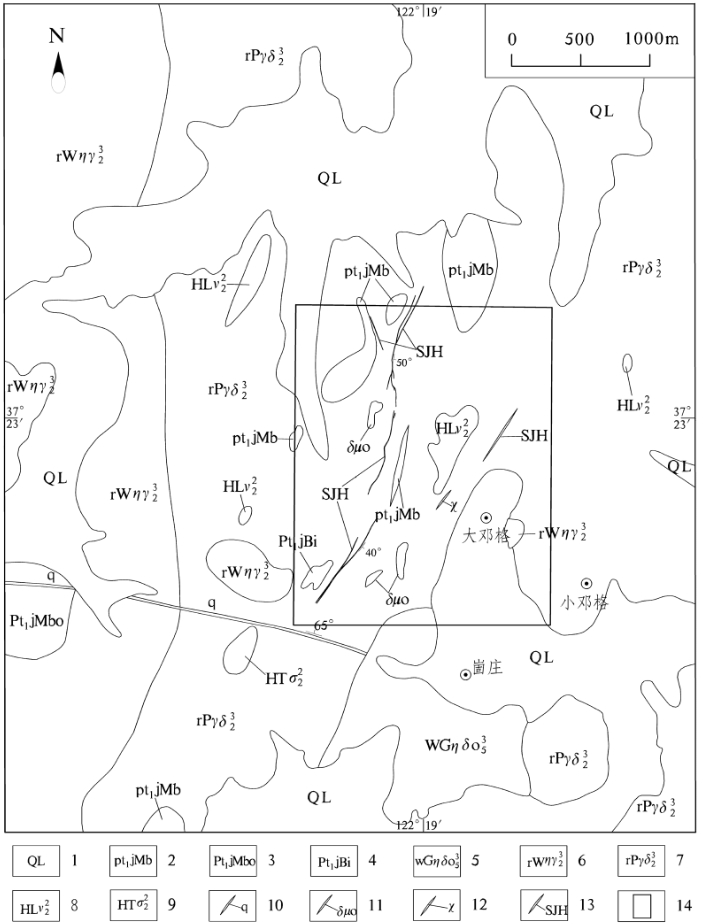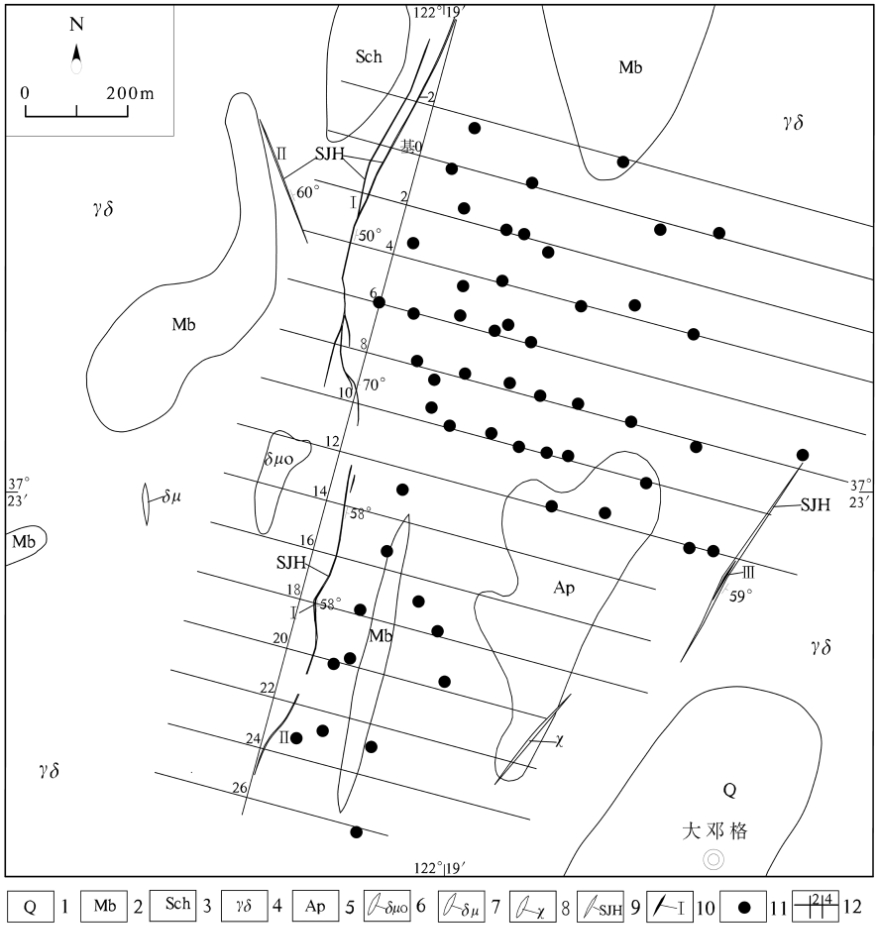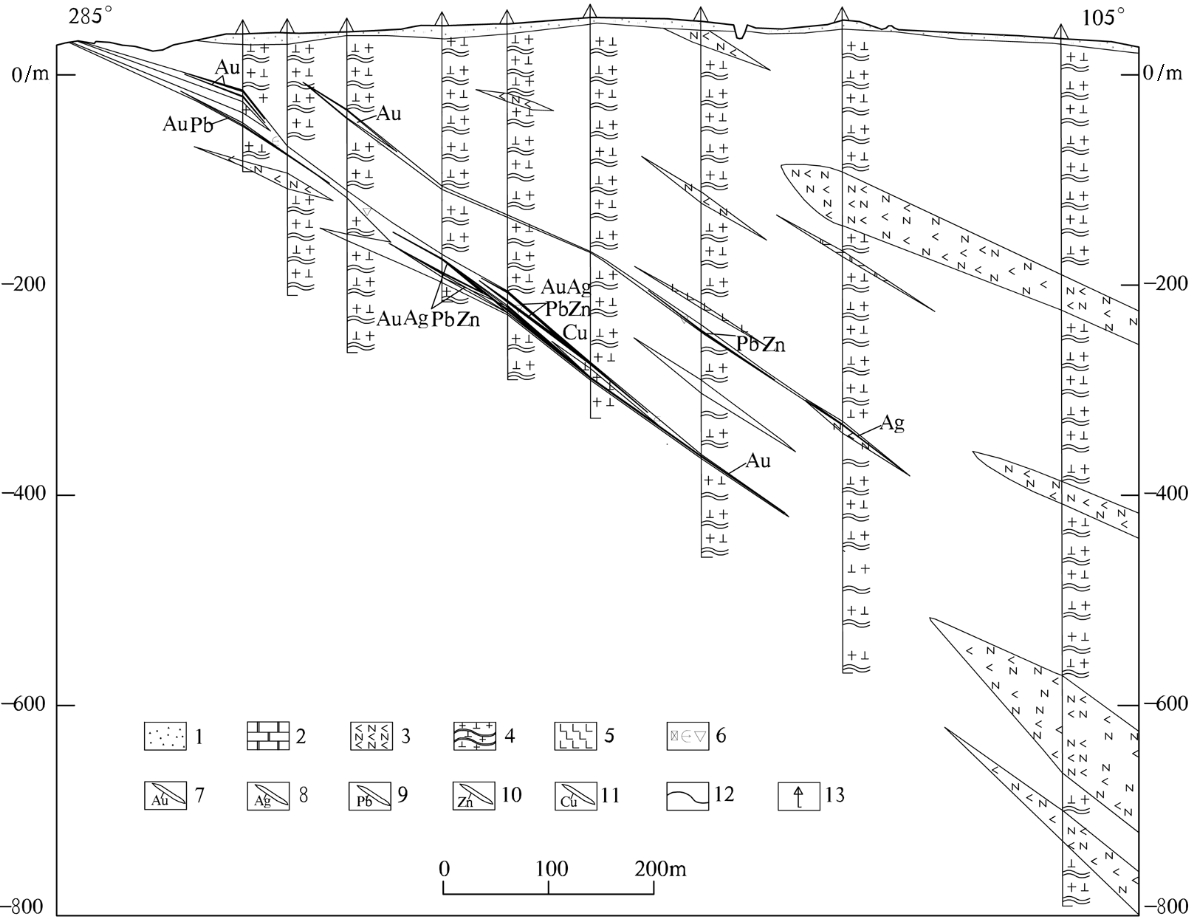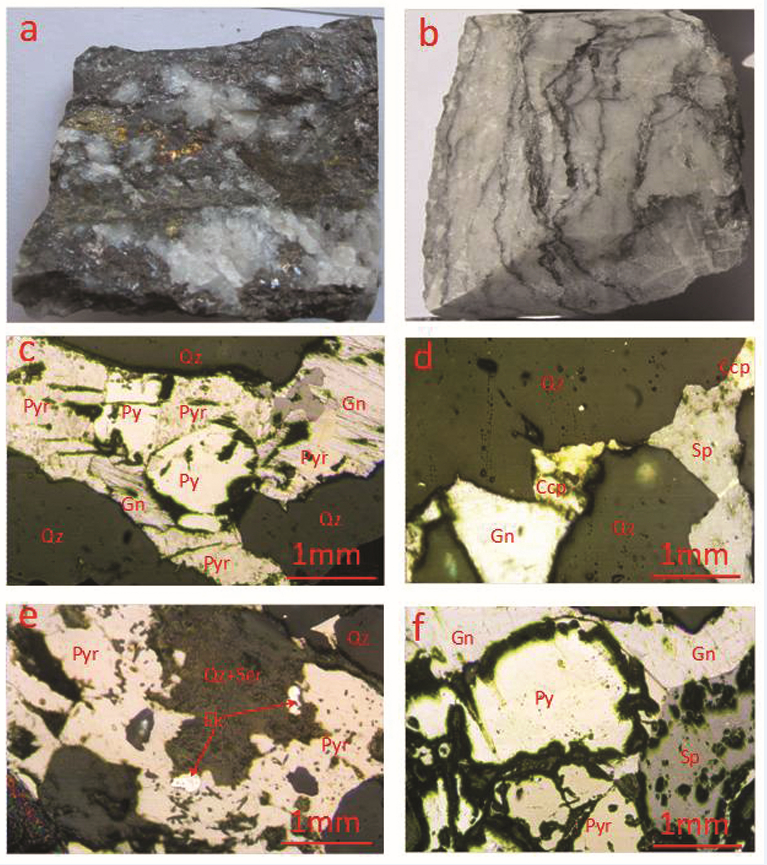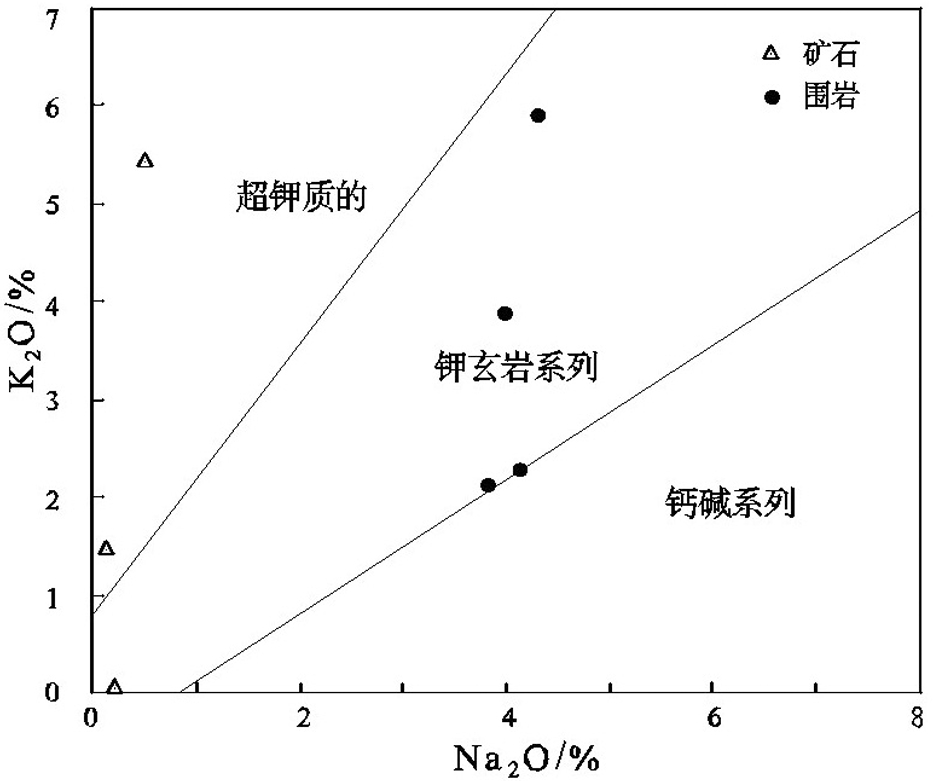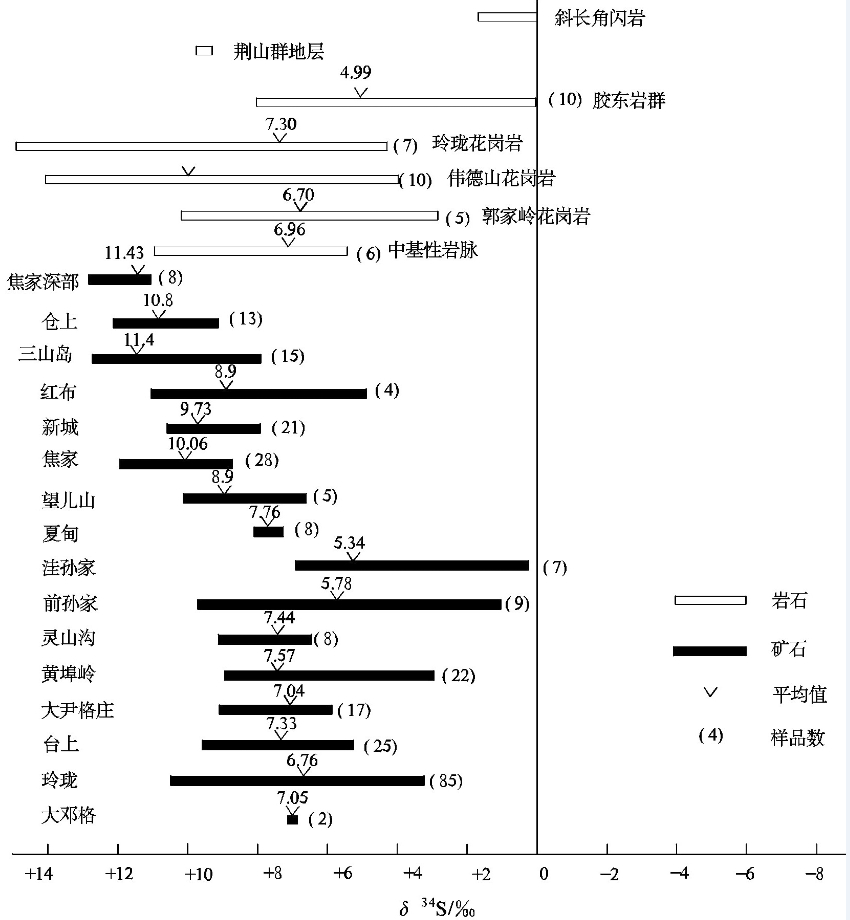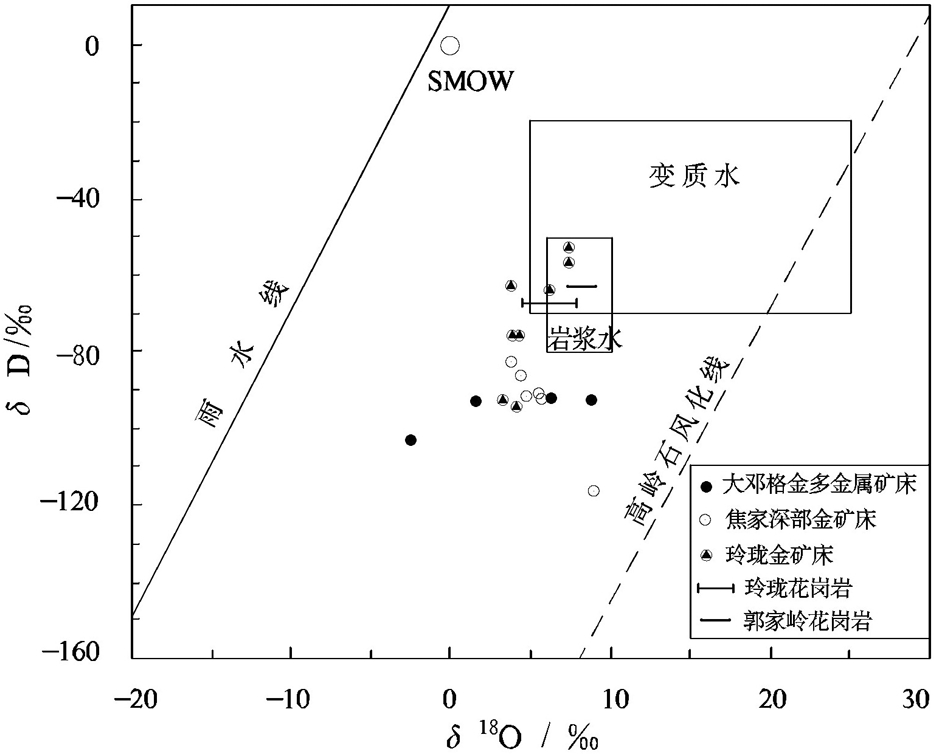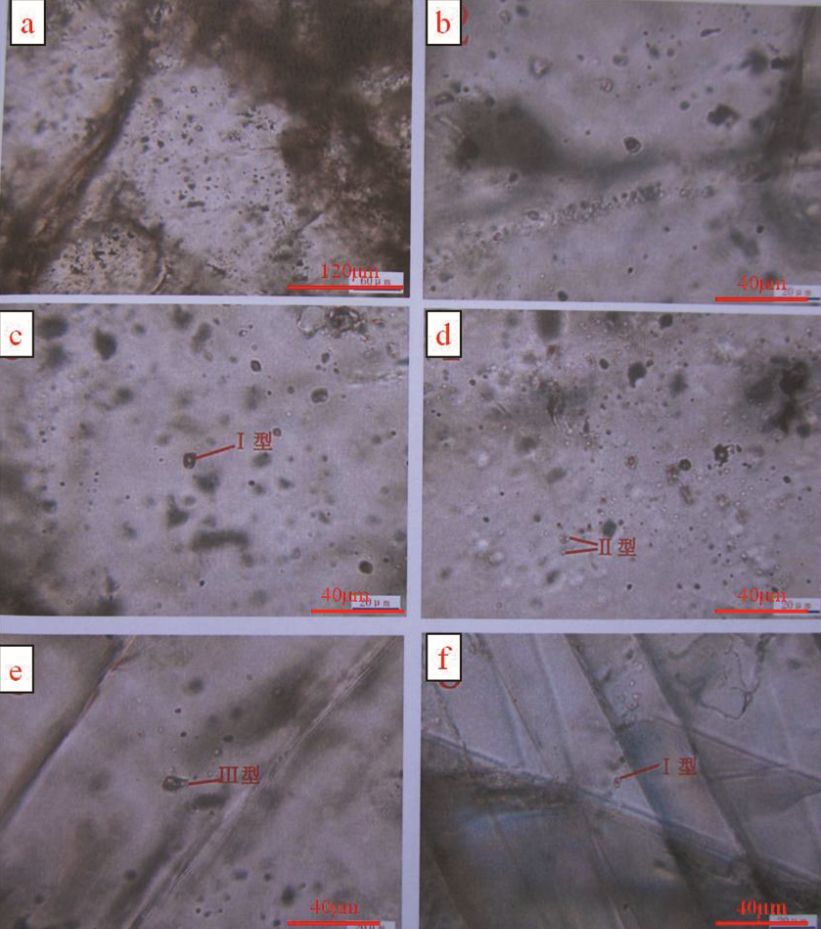Geological and geochemical features of the Dadengge gold polymetallic deposit in Jiaodong Peninsula
-
摘要: 本文介绍了大邓格金多金属矿床地质特征,对矿床主量元素、硫同位素、氢-氧同位素及流体包裹体作了测试分析,总结了矿床地球化学特征,讨论了成矿物质来源及成矿物理化学条件。主量元素分析表明蚀变过程中SiO2、K2O含量增高,Na2O、Al2O3、CaO等含量降低;硫同位素组成δ34SCDT值为7.0‰~7.1‰,指示硫可能来自于均一化程度较高的统一流体库;氢同位素组成δ DV-SMOW变化范围较大,为-83.68‰~-116.95‰,氧同位素组成δ18O水值为-2.57‰~8.35‰,显示了成矿流体以岩浆水与大气降水组成的混合水为主;成矿流体主要为中温(86~429℃)、低盐度(1.74%~22.38%NaCleq),属CO2-H2O-N2-NaCl体系。成矿期流体表现出多期、多来源特征,体系物理化学条件的改变和流体的不混溶是导致金等成矿元素沉淀和富集的重要机制。Abstract: In this paper, the authors described the geological features of the the Dadengge gold polymetallic deposit, analyzed major elements, REE, sulfur isotope, δDV-SMOW-δ18OH2O, and fluid inclusions, and then summarized the geochemical features so as to find the ore-forming genesis and physicochemical conditions. Major element analyses show that the alteration zone gained SiO2, K2O but lost Na2O, Al2O3, CaO during alteration. The sulfur isotope composition ranges between 7.0‰ and 7.1‰ δ34SCDT, suggesting that the sulfurs were of the same origin, being a unified source. The δDV-SMOW values range from -83.68‰ to -116.95‰, and theδ18OH2O values range from -2.57‰ to 8.35‰, suggesting that the mineralizing fluids were derived from the mixed magmatic and meteoric water. The mineralizing process took place under the condition of medium temperature (86-429℃) and low salinity (1.74%-22.38% NaCleq), and the mineralizing fluid might have been a CO2-H2O-N2-NaCl system. The mineralizing fluids of the main mineralization stage exhibited feature of multiple sources, and the change of physicochemical conditions and fluid immiscibility were the important mechanisms for deposition and enrichment of gold and other mineralizing elements.
-
-
图 1 胶东东部伟德山地区区域地质矿产简图(据文献[4]修改)
1—中生代白垩纪青山群(以安山岩为主);2—古元古代荆山群;3—新元古代晋宁期花岗岩;4—新元古代晋宁期花岗闪长岩;5—中生代燕山期伟德山序列崮庄单元细粒辉石角闪石英二长闪长岩;6—中生代燕山期伟德山序列洛西头单元含粗斑中粒角闪黑云石英二长岩;7—中生代燕山期伟德山序列大水泊单元疏粗斑中粒含黑云角闪石英二长岩;8—中生代燕山期伟德山序列不落耩单元疏巨斑中粗粒含角闪石英二长岩;9—中生代燕山期伟德山序列崖西单元疏粗斑中粒含角闪二长花岗岩;10—中生代燕山期伟德山序列虎头石单元细粒二长花岗岩;11—石英闪长玢岩;12—闪长玢岩;13—花岗斑岩;14—二长斑岩;15—岩性/地层界线;16—断层及产状;17—伟德山岩体出露外界线;18—铜/钼/铅/锌/银/金矿床(点)
Figure 1. Simplified geological map and distribution of main nonferrous metal deposit in the eastern area of Jiaodong Peninsula (modified after reference [4])
1-Mesozoic Cretaceous Qingshan Group (andesite);2-Paleoproterozoic Jingshan Group;3-Neoproterozoic Jinning period granite; 4-Neoproterozoic Jinning period granodiorite;5-Mesozoic YanshanianWeideshan granite series:Guzhuang unit,monzonitic diorite; 6-Luoxotou unit,adamellite;7-Dashuipo unit,adamellite;8-Buluojiang unit,adamellite;9-Yaxi unit;10-Hutoushi unit,monzonitic granite; 11-Porphyritic quaitzdiorite;12-Porphyritic diorite;13-Granophyre;14-Porphyritic monzonite;15-Geological boundary; 16-Fault and its attitude;17-Boundary ofWeideshan granite;18-Copper/molybdenum/lead/zinc/silver/gold deposits (ore spots)
图 2 大邓格金多金属矿区域地质图(据文献[1]修改)
1—新生代第四系;2—古元古代荆山群定国寺段透辉石大理岩;3—古元古代荆山群安吉村段二云石英片岩;4—古元古代荆山群安吉村段黑云片岩;5—中生代白垩纪伟德山序列崮庄单元片麻状细粒辉石石英闪长岩;6—新元古代荣成片麻岩套威海单元条带状细粒含黑云二长花岗质片麻岩;7—新元古代荣成片麻岩套泊于单元条纹状中细粒含角闪黑云花岗闪长岩质片麻岩;8—中元古代长城纪海阳所组合老黄山单元变辉长辉绿岩、斜长角闪岩;9—中元古代长城纪海阳所组合通海单元蛇纹岩、含橄榄透闪石岩;10—石英脉;11—石英闪长玢岩;12—煌斑岩;13—黄铁绢英岩化碎裂岩;14—勘查区范围
Figure 2. Regional geological map of the Dadengge gold polymetallic deposit (modified after reference [1])
1-Cenozoic Quaternary;2-Proterozoic Jingshan Group Dingguosi Member:diopside marble;3-Proterozoic Jingshan Group Anjicun Member: two-mica quartz schist;4-Proterozoic Jingshan Group Anjicun Member:biotite schist;5-Mesozoic CretaceousWeideshan granite series Guzhuang unit:gneissic granule pyroxene quartz diorite;6-Proterozoic Rongcheng bandedWeihai Unit:stripped granule monzonitic granitic gneiss including biotite;7-Proterozoic Rongcheng banded Poyu Unit:striated medium-granule biotite granodioritic gneiss including amphibole; 8-Proterozoic Changcheng period Haiyangsuo Combination Laohuangshan Unit:meta-gabbro,diabase,plagioclase amphibolite;9-Proterozoic Changcheng period Haiyangsuo Combination Tonghai Unit:serpentinite,tremolite rock including olivine;10-quartz;11-Quartz dioriteporphyrite; 12-Lamprophyre;13-Cataclasite with pyritization,sericitization and greisenization;14-Faults;15-Range of exploratory area
图 3 大邓格金多金属矿区地质图(据文献[1]修改)
1—第四系;2—大理岩;3—黑云片岩;4—花岗闪长质片麻岩;5—斜长角闪岩;6—石英闪长玢岩;7—闪长玢岩;8—煌斑岩;9—黄铁绢英岩化碎裂岩;10—矿脉编号;11—钻孔;12—勘探线及编号
Figure 3. Simplified geological map of the Dadengge gold polymetallic deposit (modified after reference [1])
1- Quaternary;2-Marble;3-Biotite schist;4-Granodioritic gneiss;5-Plagioclase amphibolite;6-Quartz diorite-porphyrite;7-Diorite-porphyrite;8-Lamprophyre;9-Cataclasite with pyritization,sericitization and greisenization;10-Serial number of the mineral vein;11-Drill hole;12-Exploration line and its serial number
图 4 大邓格金多金属矿床8号勘探线地质剖面图(据文献[1]修改)
1—第四系;2—大理岩;3—斜长角闪岩;4—花岗闪长质片麻岩;5—煌斑岩;6—黄铁绢英岩化碎裂岩;7—金矿体;8—银矿体;9—铅矿体;10—锌矿体;11—铜矿体;12—地质界线;13—钻孔
Figure 4. Geological section along No. 8 exploration line in the Dadengge gold polymetallic deposit (modified after reference [1])
1-Quaternary; 2-Marble; 3-Plagioclasic amphibolite; 4-Granodioritic gneiss; 5-Lamprophyre; 6-Cataclasite with pyritization, sericitization and silicification; 7-Gold orebody; 8-Silver orebody; 9-Lead orebody; 10-Zinc orebody; 11-Copper orebody; 12-Geological boundary; 13-Drill hole
图 5 大邓格金多金属矿床矿石及显微照片
Py—黄铁矿;Ccp—黄铜矿;Pyr—磁黄铁矿;Qz—石英;Ser—绢云母;Gn—方铅矿;Sp—闪锌矿;Ele—银金矿;a—黄铁绢英岩化碎裂岩型矿石(内有石英脉)(金-银-铜-铅-锌共生),ZK802,221 m;b—黄铁矿石英脉型矿石(铅-铜-金-银共生),ZK604,140 m;c—方铅矿(他形)沿黄铁矿、磁黄铁矿、石英晶隙嵌布;d—黄铜矿微粒以不混溶体被包于闪锌矿之中(乳浊状),或呈他形粒状集合体产出;e—银金矿沿磁黄铁矿与石英和绢云母边缘嵌布;f—闪锌矿、方铅矿(他形)与黄铁矿、磁黄铁矿(半自形)共生
Figure 5. Micrograph of ores in the Dadengge gold polymetallic deposit
Py-Pyrite;Ccp-Chalcopyrite;Pyr-Pyrrhotite;Qz-Quartz;Ser-Sericite;Gn-Galena;Sp-Sphalerite;Ele-Electrum;a-Cataclasite type ore with pyritization,sericitization and silicification (quartz included)(composite orebody of Au-Ag-Cu-Pb-Zn),ZK802,221 m;b-Pyrite and quartz vein type ore (composite orebody of Pb-Cu-Au-Ag),ZK604,140 m;c-Galena (allotriomorphic) distributed along crystals'slits of pyrite,pyrrhotite, quartz;d-Chalcopyrite inlaid in sphalerite (opacification),or exhibiting allotriomorphic granular aggregation;e-Electrum inlaid along edge of quartz and sericite;f-Sphalerite and galena (allotriomorphic) associated with pyrite and pyrrhotite (subhedron)
图 9 大邓格金多金属矿床流体包裹体特征
a—石英中成群分布的包裹体;b—方解石中成群分布的包裹体;c—石英中无色-灰色Ⅰ型富液相包裹体;d—石英中深灰色Ⅱ型CO2两相包裹体;e—石英中Ⅲ型H2O-CO2三相包裹体;f—方解石中无色-灰色Ⅰ型富液相包裹体
Figure 9. Characteristics of fluid inclusions in the Dadengge gold polymetallic deposit
a-Inclusion group in quartz;b-Inclusion group in calcite; c-Ⅰ type rich liquid inclusions in quartz; d-Ⅱtype V CO2-L CO2 inclusions in quartz;e-Ⅲ type rich H2O-CO2 three-phase inclusions in quartz; f-Ⅰ type rich liquid inclusions in calcite
表 1 大邓格金多金属矿床矿石及围岩主量元素分析结果(%)
Table 1 Major element content of orebodies and country rocks in the Dagengge gold polymetallic deposit
序号 样品编号 取样位置/m 岩性 Si02 ai2o3 Fe203 FeO MgO CaO Na20 K20 MnO Ti02 P2O5 烧失量 总和 1 ZK805-1 414.30 矿石 SJH 61.15 0.81 12.25 9.72 2.94 15.51 0.13 0.02 1.57 0.04 0.14 5.33 109.61 2 ZK808-1 262.60 SJH 74.95 12.93 1.84 1.34 0.64 1.75 0.48 5.42 0.09 0.34 0.08 1.43 101.29 3 ZK1002-1 266.50 SJH 79.06 4.82 4.16 0.72 0.66 4.42 0.08 1.55 0.05 0.32 0.30 4.51 100.65 4 ZK805-2 481.20 围岩 πγ 71.71 14.24 1.42 0.57 0.31 0.67 4.12 5.88 0.08 0.21 0.07 1.27 100.55 5 DDG-17 地表 νηδ 56.98 16.72 6.60 3.81 4.67 6.77 4.04 2.29 0.10 0.65 0.38 0.79 103.80 6 WH-1 外围 ηγ 71.90 13.65 1.01 1.87 0.60 1.54 4.01 3.83 0.06 0.27 0.09 0.36 99.19 7 PYJ-1 外围 γδ 64.30 15.46 2.75 3.52 1.85 4.43 3.85 2.09 0.15 0.46 0.10 - 98.96 注:SJH—黄铁绢英岩化碎裂岩;πγ—斑状花岗岩;νηδ—辉石二长闪长岩;ηγ—条带状片麻状细粒黑云二长花岗岩;γδ—条纹片麻状中细粒含角闪黑云花岗闪长岩;6号样引自文献[5];7号样引自文献[6]。 表 2 大邓格金多金属矿床硫同位素组成
Table 2 Sulfur isotope composition of the Dadengge gold polymetallic deposit
序号 样品编号 取样位置/m 矿体编号 岩性 测试对象 δ34Sv.cdt‰ 1 ZK604-1 134.00 锌矿体 绢英岩化碎裂岩 闪锌矿 7.0 2 ZK803 85.00 铅锌矿体 花岗质碎裂岩 闪锌矿 7.1 表 3 大邓格金多金属矿床及胶东典型金矿床氢-氧同位素组成表
Table 3 Hydrogen and oxygen isotope composition of the Dadengge deposit and the typical gold deposits in Jiaodong
矿床 样品编号 取样位置/m 测试矿物 岩性 δDv_smow‰ δ18Ov.smow‰ δ180水‰ 数据来源 大邓格金多金属矿床 ZK804-l-a 328.70 石英 SJH -92.50 16.00 8.35 本文 ZK804-2-a 342.50 石英 SJH -91.30 13.20 5.57 ZK805-l-a 414.30 石英 SJH -101.80 5.00 -2.57 ZK1002-l-a 266.50 石英 SJH -92.10 8.60 1.01 焦家深部金矿床 ZK634 石英 SγJH -90.16 12.88 4.95 文献[19] ZK615-6 石英 SJH -92.76 13.24 5.31 ZK634-9 石英 SγJH -83.68 12.04 4.11 ZK622-3 石英 SJH -116.96 16.28 8.35 ZK667-11 石英 SγJH -91.38 13.04 5.11 ZK622-5 石英 SγJH -87.15 12.45 4.52 玲珑金矿床 石英 -85.00 13.60 4.20 文献[20] 石英 -76.00 14.10 4.00 石英 -93.00 12.60 3.20 石英 -76.00 13.70 4.30 石英 -62.00 13.20 3.80 文献[21] 石英 -64.00 12.20 6.10 石英 -54.00 16.60 7.20 石英 -58.00 15.00 7.20 玲珑花岗岩 花岗岩全岩 γ -68.40 8.30 4.70-7.60 文献[22 郭家岭花岗岩 花冈石全石 γ -62.40 10.10 7.10 9.10 表 4 大邓格金多金属矿床流体包裹体显微测温结果
Table 4 Microthermometric data of fluid inclusions in the Dadengge gold polymetallic deposit
样号 岩石类型 取样位置 测试矿物 包裹休类型 气液比/% ThCO2/°C Th/°C 盐度/(%NaCl) 密度/(g/cm3) 富液相包裹体 10~30 283~321 4.8~12.42 0.74~0.87 ZK804-1 SJH 342.50 m Ⅰ-6号矿体 石英 CO2两相包裹体 30 31.60 H2O-CO2三相包裹体 30~80 28.20~31.00 282~360 4.87~12.45 0.65~0.89 富液相包裹体 20~40 212~412 4.26~11.75 0.66—0.94 ZK808-2 SJH 269.60m I-6号矿体 石英 CO2两相包裹体 40~60 26.00~29.20 H2O-CO2三相包裹体 20~60 23.60~28.60 280~429 4.14~11.65 0.68~0.77 ZK808-4 SJH 273.60 m Ⅰ-2号矿体 方解石 富液相包裹体 5~10 86~126 9.08~14.97 1.00—1.07 石英 富液相包裹体 10 255 22.38 1.00 ZK1005-1 SJH 226.80 m Ⅰ-2号矿体 石英 富液相包裹体 8~20 96~129 1.74~4.96 0.97—0.98 ZK1002-1 SJH 266.50 m Ⅰ-2号矿体 石英 富液相包裹体 5~20 142~317 2.07~20.45 0.76~1.08 表 5 大邓格金及多金属矿床流体包裹体气相成分表
Table 5 Gas phase composition of inclusions in the Dadengge gold polymetallic deposit
样品编号 测试矿物 源石 含量/10-6 h2 n2 CO ch4 CO2 H2O(气相) ZK804-1 石英 黄铁绢英岩化碎裂岩 0.81 1.12 0.25 0.24 17.56 1.76×105 ZK1002-1 石英 黄铁绢英岩化碎裂岩 0.17 3.01 0.21 0.29 3.37 3.93×104 -
[1] 山东省第六地质矿产勘查院. 山东省威海市经济技术开发区大邓格矿区金及多金属矿详查报告[R]. 2012. Shandong Provincial 6th Exploration Institute of Geology and Mineral Resources. Detailed survey report of Dadengge complex deposit in Economy and Technology Development Area of Weihai City, Shandong Province[R]. 2012, (in Chinese). [2] 孔庆友, 张天祯, 于学峰, 等. 山东矿床[M]. 济南:山东科学技术出版社, 2006:384-386. Kong Qingyou, Zhang Tianzhen, Yu Xuefeng, et al. Shandong Deposits[M]. Ji'nan:Shandong Science and Technology Publishing House, 2006:384-386(in Chinese). [3] 于学贵, 等. 山东省威海地质矿产概论[R]. 威海市地质矿产处内部资料, 1999:7. Yu Xuegui, et al. Generality of Geology and Mineral in Weihai City, Shandong Province[R]. Inner Data of Department of Geology and Mineral inWeihai City, 1999:7(in Chinese). [4] 丁正江, 孙丰月, 刘福来, 等. 胶东伟德山地区铜钼多金属矿锆石U-Pb法测年及其地质意义[J].岩石学报, 2013, 29(2):607-618. Ding Zhengjiang, Sun Fengyue, Liu Fulai, et al. U-Pb dating of zircons from the Weideshan molybdenum copper polymetallic deposit in Jiaodong Peninsula, China, and its geological significance[J]. Acta Petrologica Sinica, 2013, 29(2):607-618(in Chinese with English abstract). [5] 王兰中, 王来明. 荣成超单元的基本特征[J]. 山东地质, 1994, 10(2):13-23. Wang Lanzhong, Wang Laiming. Basic features of Rongcheng Superunit[J]. Shandong Geology, 1994, 10(2):13-23(in Chinese with English abstract). [6] 张丕建, 刘殿浩. 胶东东部荣成超单元的岩石谱系划分及成因探讨[J]. 山东地质, 1998, 14(2):19-26. Zhang Peijian, Liu Dianhao. Classification of rock pedigree of Rongcheng Superunit and discussion on its origin[J]. Shandong Geology, 1998, 14(2):19-26(in Chinese with English abstract). [7] Rickwood P C. Boundary lines within petrologic diagrams which use oxides of major and minor elements[J]. Lithos, 1989, 22(2):247-263.
[8] 韩吟文, 马振东. 地球化学[M]. 北京:地质出版社,2004. Han Yinwen, Ma Zhendong. Geochemistry[M]. Beijing:Geological Publishing House, 2004(in Chinese). [9] 邱家骧. 岩浆岩岩石学[M]. 北京:地质出版社. 1985. Qiu Jiaxiang. Magmatic Petrology[M]. Beijing:Geological Publishing House, 1985(in Chinese). [10] 于炳松, 赵志丹, 苏尚国. 岩石学[M]. 北京:地质出版社, 2011. Yu Bingsong, Zhao Zhidan, Su Shangguo. Petrology[M]. Beijing:Geological Publishing House, 2011(in Chinese). [11] 李杰, 李世勇, 毕明光, 等. 胶东地区早白垩世金-钼-铜-铅锌矿床成矿作用及成矿模式[M]. 北京:地质出版社, 2015. Li Jie, Li Shiyong, Bi Mingguang, et al. Metallization and Metallogenetic Model of Early Cretaceous Au-Mo-Cu-Pb-Zn Nonferrous Metal Deposits in Jiaodong Peninsula[M]. Beijing:Geological Publishing House, 2015(in Chinese). [12] 李俊健. 华北陆块主要成矿区带成矿规律和找矿方向研究[M]. 天津:天津科技出版社, 2006:297-312. Li Junjian. Metallogeny and Prospecting Direction of Main Metallogenic Belts in North China Block[M]. Tianjin:Tianjin Science and Technology Press, 2006:297-312(in Chinese). [13] 毛景文, 李厚民, 王义天, 等. 地幔流体参与胶东金矿成矿作用的氢氧碳硫同位素证据[J]. 地质学报, 2005, 79(6):839-857. Mao Jingwen, Li Houmin, Wang Yitian, et al. The relationship between mantle-derived fluid and gold ore-formation in the eastern Shandong Peninsula:Evidences from D-O-C-S isotopes[J]. Acta Geologica Sinica, 2005, 79(6):839-857(in Chinese with English abstract). [14] 张竹如, 陈世祯. 胶东金矿成矿域胶莱盆地中超大型金矿床找矿远景[J]. 地球化学, 1999,28(3):203-212. Zhang Zhuru, Chen Shizhen. Superlarge gold deposit exploration perspective in Jiaolai Basin of Jiaodong gold metallogenetic domain[J]. Geochimica, 1999, 28(3):203-212(in Chinese with English abstract). [15] 侯明兰, 蒋少涌, 姜耀辉, 等. 胶东蓬莱金成矿区的S-Pb同位素地球化学和Rb-Sr同位素年代学研究[J].岩石学报, 2006, 22(10):2525-2533. Hou Minglan, Jiang Shaoyong, Jiang Yaohui, et al. S-Pb isotope geochemistry and Rb-Sr geochronology of the Penglai gold field in the eastern Shandong Province[J]. Acta Petrologica Sinica, 2006, 22(10):2525-2533(in Chinese with English abstract). [16] 张连昌, 沈远超, 曾庆栋, 等. 山东中生代胶莱盆地北缘金矿床硫铅同位素地球化学[J]. 矿物岩石地球化学通报,2001, 20(4):380-384. Zhang Lianchang, Shen Yuanchao, Zeng Qingdong, et al. Sulfur and lead isotopic geochemistry of gold deposits at the northern margin of Jiaolai Basin, east Shandong[J]. Bulletin of Mineralogy, Petrology and Geochemistry, 2001, 20(4):380-384(in Chinese with English abstract). [17] 宋明春, 宋英昕, 沈昆, 等.胶东焦家深部金矿矿床地球化学特征及有关问题讨论[J]. 地球化学, 2013, 42(3):2749-289. Song Mingchun, Song Yingxin, Shen Kun, et al. Geochemical features of deeply-seated gold deposit and discussions on some associated problems in Jiaodong gold ore field, Shandong Peninsula, China[J]. Geochimica, 2013, 42(3):2749-289(in Chinese with English abstract). [18] 张理刚. 稳定同位素在地质科学中的应用[M]. 西安:陕西科学技术出版社, 1985. Zhang Ligang. Geological Application for the Stable Isotope[M]. Xi'an:Shaanxi Science and Technology Press,1985(in Chinese). [19] 宋明春, 崔书学,伊丕厚, 等.胶西北金矿集中区深部大型-超大型金矿找矿与成矿模式[M]. 北京:地质出版社, 2010:173-214. Song Mingchun, Cui Shuxue, Yi Pihou, et al. Prospecting and Metallogenic Model of Large and Super-large-scale Deepseated Gold Deposits in Northwestern Shandong Peninsula Concentration Region of Gold Deposits[M]. Beijing:Geological Publishing House, 2010:173-214(in Chinese). [20] 张理刚, 陈振胜, 刘敬秀, 等. 焦家式金矿水-岩交换作用:成矿流体来源及成因[J]. 矿床地质, 1994, 13(3):193-200. Zhang Ligang, Chen Zhensheng, Liu Jingxiu, et al. Water-rock exchange in the Jiaojia type gold deposit:A study of hydrogen and oxygen isotopic compositions of ore-formation fluids[J]. Mineral Deposits, 1994, 13(3):193-200(in Chinese with English abstract). [21] 杨忠芳, 徐景奎, 赵伦山, 等. 胶东两大成因系列金矿石英包裹体氢氧同位素及成矿流体组分地球化学研究[J]. 矿物学报, 1991, 11(4):363-369. Yang Zhongfang, Xu Jingkui, Zhao Lunshan, et al. Geochemical studies of hydrogen and oxygen isotopes and ore-forming fluid compositions of fluid inclusions in quartz from two types of gold deposits in Jiaodong[J]. Acta Mineral Sinica, 1991, 11(4):363-369(in Chinese with English abstract). [22] 徐金芳, 沈步云, 牛良柱, 等. 胶北地块与金矿有关的花岗岩类的研究[J]. 山东地质, 1989, 5(2):1-110. Xu Jinfang, Shen Buyun, Niu Liangzhu, et al. Study of the granitoids related to gold deposits in Jiaodong Block, Shandong Province[J]. Shandong Geology, 1989, 5(2):1-110(in Chinese with English abstract). [23] Ohmoto H. Stable isotope geochemistry of ore deposits[J]. Reviews of Mineralogy,1986,16:491-559.
[24] Sheppard S M F. Characterization and isotopic variations in natural waters[J]. Reviews of Mineralogy,1986,16:165-183.
[25] 侯明兰, 蒋少涌, 沈昆, 等. 胶东蓬莱金矿区流体包裹体和氢氧同位素地球化学研究[J].岩石学报, 2007, 23(9):2241-2256. Hou Minglan, Jiang Shaoyong, Shen Kun, et al. Fluid inclusion and H-O isotope study of gold mineralization in the Penglai gold field, Eastern Shandong[J]. Acta Petrologica Sinica, 2007, 23(9):2241-2256(in Chinese with English abstract). [26] 张连昌, 沈远超, 李厚民, 等. 胶东地区金矿床流体包裹体的He, Ar同位素组成及成矿流体来源示踪[J]. 岩石学报, 2002, 18(4):559-565. Zhang Lianchang, Shen Yuanchao, Li Houmin, et al. Helium and argon isotopic compositions of fluid inclusions and tracing to the source of ore-forming fluids for Jiaodong gold deposits[J]. Acta Petrologica Sinica, 2002, 18(4):559-565(in Chinese with English abstract). [27] 李建威, 毕诗健, Vasconcelos Paulo. 胶东苏鲁地体范家埠金矿成矿作用与矿床成因浅析:兼与胶北地体金矿对比[J]. 高校地质学报, 2010, 16(2):125-142. Li Jianwei, Bi Shijian, Vasconcelos Paulo. Mineralization and genesis of the Fanjiabu gold deposit in the Sulu Ultrahigh Pressure Metamorphic Terrane, with a comparison to the gold mineralization in the Jiaobei Terrane[J]. Geological Journal of China Universities, 2010, 16(2):125-142(in Chinese with English abstract). [28] 齐钒宇, 张志, 祝新友, 等. 湖南黄沙坪钨钼多金属矿床矽卡岩地球化学特征及其地质意义[J]. 中国地质, 2012, 39(2):338-348. Qi Fanyu, Zhang Zhi, Zhu Xinyou, et al. Skarn geochemistry of the Huangshaping W-Mo polymetallic deposit in Hunan and its geological significance[J]. Geology in China, 2012, 39(2):338-348(in Chinese with English abstract). [29] 王喜龙, 刘家军, 翟德高, 等. 内蒙古林西边家大院银多金属矿床同位素地球化学特征及成矿物质来源探讨[J]. 中国地质, 2014, 41(4):1288-1303. Wang Xilong, Liu Jiajun, Zhai Degao, et al. A study of isotope geochemistry and sources of ore-forming materials of the Bianjiadayuan silver polymetallic deposit in Linxi, Inner Mongolia[J]. Geology in China, 2014, 41(4):1288-1303(in Chinese with English abstract). [30] 胡正华, 王先广, 李永明, 等. 长江中下游九瑞矿集区宝山铜多金属矿床辉钼矿Re-Os年龄及其地质意义[J]. 中国地质, 2015, (2):585-596. Hu Zhenghua, Wang Xianguang, Li Yongming, et al. Re-Os age of molybdenite from the Baoshan copper polymetallic deposit in the Jiurui ore concentration area along the middle-lower Yangtze River region and its geological significance[J]. Geology in China, 2015, (2):585-596(in Chinese with English abstract). [31] 李杰, 宋明春, 王美云, 等.胶东尚家庄钼矿床Re-Os同位素年龄及其地质意义[J]. 中国地质, 2013,40(5):1612-1621. Li Jie, Song Mingchun, Wang Meiyun, et al. The molybdenite Re-Os age and genetic analysis of the Shangjiazhuang Mo deposit in Jiaodong area[J]. Geology in China, 2013,40(5):1612-1621(in Chinese with English abstract). [32] 赫英, 毛景文, 王瑞廷, 等. 幔源岩浆去气形成富二氧化碳含金流体——可能性与现实性[J]. 地学前缘, 2001, 8(4):265-270. He Ying, Mao Jingwen, Wang Ruiting, et al. Carbon dioxide rich and gold bearing fluids degassed from mantle derived magma-reality and possibility[J]. Earth Science Frontiers, 2001, 8(4):265-270(in Chinese with English abstract). [33] 宋明春, 宋英昕, 李杰, 等. 胶东与白垩纪花岗岩有关的金及有色金属矿床成矿系列[J]. 大地构造与成矿学, 2015, 39(5):828-843. Song Mingchun, Song Yingxin, Li Jie, et al. Metallogenic series of gold and nonferrous metal deposits related tocretaceous granites in eastern Shandong Peninsula, China[J]. Geotectonica et Metallogenia,2015, 39(5):828-843(in Chinese with English abstract). -
期刊类型引用(15)
1. 智云宝,侯广顺,郝兴中,孙聪聪,刘汉栋,张春池,李凤春. 山东栖霞大河崖金矿床包裹体特征研究及矿床成因初探. 矿产勘查. 2024(02): 212-222 .  百度学术
百度学术
2. 邹占春,刘俊玉,陈建,李景波,丁正江,孙丽莎,李双飞,唐名鹰,张蕾,王欣然. 胶东西南部三合山岩体岩石成因和构造背景:年代学、地球化学及Sr-Nd-Pb-Hf同位素约束. 中国地质. 2024(04): 1387-1410 .  本站查看
本站查看
3. 王珊珊,丁正江,滕飞,董小涛,吕军阳,王斌,刘家良. 与伟德山期岩浆岩有关的多金属成矿作用研究——以夼北矽卡岩型铜矿床为例. 黄金. 2024(10): 1-8 .  百度学术
百度学术
4. 王美云,李杰,宋明春,张丽鹏,唐宗源,丁正江. 胶东大邓格金多金属矿床成矿机制:来自黄铁矿Rb-Sr定年、原位硫同位素及微量元素的制约. 岩石学报. 2023(05): 1501-1515 .  百度学术
百度学术
5. 宋明春,胡文萱,李杰,丁正江,宋英昕,彭永和. 胶东型金矿成矿系列及找矿案例. 地球学报. 2023(05): 781-796 .  百度学术
百度学术
6. 李杰,安梦莹,宋明春,王美云,丁正江,鲍中义,王珊珊. 胶东金矿硫同位素组成特征及其来源. 地质通报. 2022(06): 993-1009 .  百度学术
百度学术
7. 倪璋懿,李杰,刘吉强. 胶东大邓格金—多金属矿床热液蚀变过程中的元素迁移. 山东国土资源. 2022(07): 1-11 .  百度学术
百度学术
8. 黄鑫. 胶东大柳行金矿矿床特征及成因探讨. 西北地质. 2021(04): 129-141 .  百度学术
百度学术
9. 胡浩,张昆,严加永,邵陆森,付光明. 山东胶东半岛焦家断裂带南缘电性结构研究. 地质学报. 2020(02): 661-674 .  百度学术
百度学术
10. 智云宝,孙海瑞,李风华. 山东栖霞笏山金矿床成因——元素地球化学与流体包裹体证据. 吉林大学学报(地球科学版). 2020(05): 1552-1569 .  百度学术
百度学术
11. 唐文龙,付超,邹键,戴广凯,彭丽娜,朱学强,马方. 胶东成矿区栖霞-牟平地区1∶50000地质矿产调查数据库. 中国地质. 2020(S2): 70-107 .  本站查看
本站查看
12. 杨俊杰. 金属矿床地质地球化学特征及找矿措施. 化工管理. 2019(13): 96-97 .  百度学术
百度学术
13. 于文龙,王萌,王天姿,陈志楠. 金属矿床地质地球化学特征及找矿方法研究. 建材与装饰. 2018(28): 224 .  百度学术
百度学术
14. 王珊珊,霍光,姜帆,杨立新. 胶东东部威海地区金及有色金属成矿系列. 山东国土资源. 2018(10): 49-56 .  百度学术
百度学术
15. SONG Mingchun,WANG Shanshan,YANG Lixin,LI Jie,LI Shiyong,DING Zhengjiang. Metallogenic Epoch of Nonferrous Metallic and Silver Deposits in the Jiaodong Peninsula, China and its Geological Significance. Acta Geologica Sinica(English Edition). 2017(04): 1305-1325 .  必应学术
必应学术
其他类型引用(5)



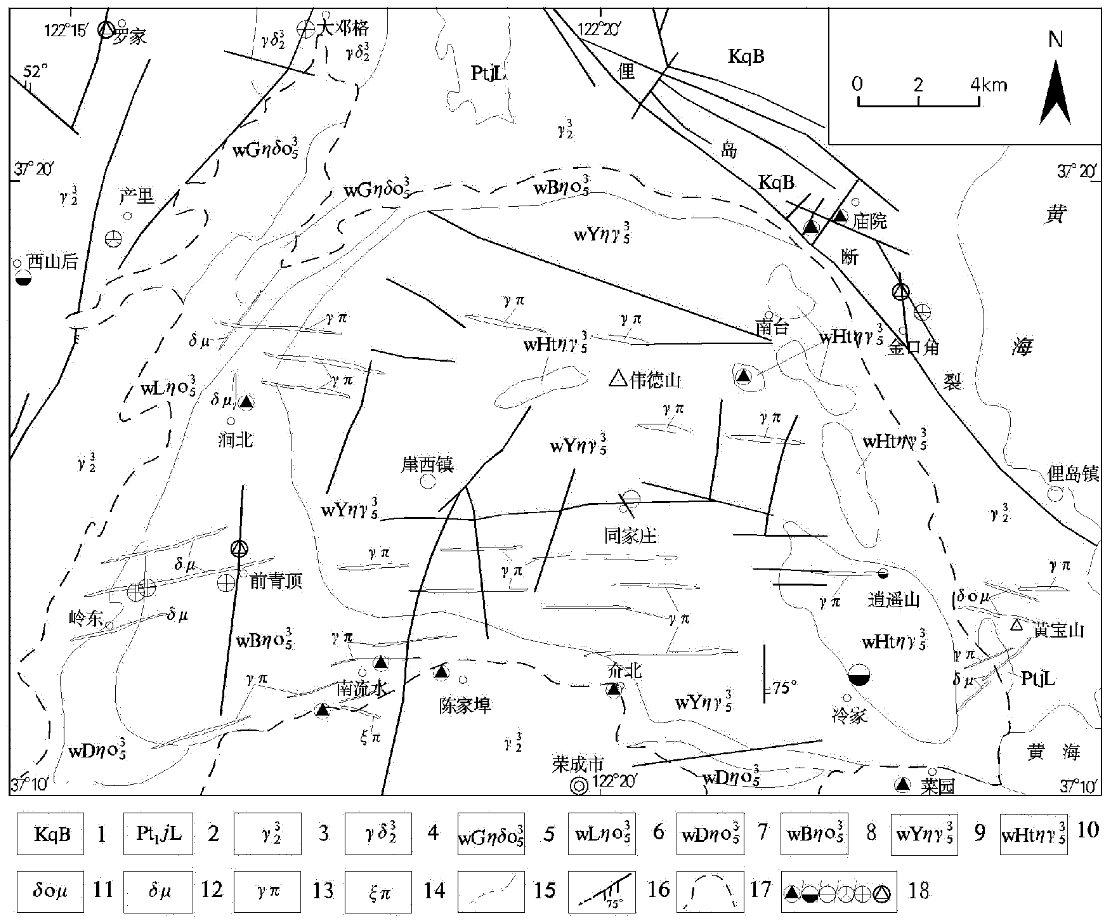
 下载:
下载:
